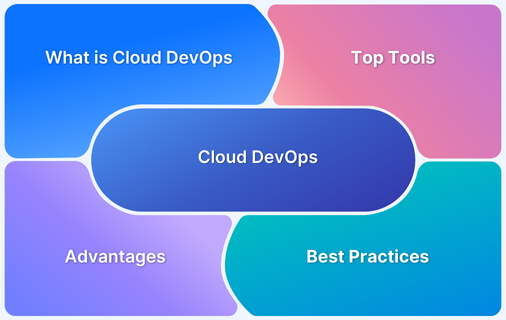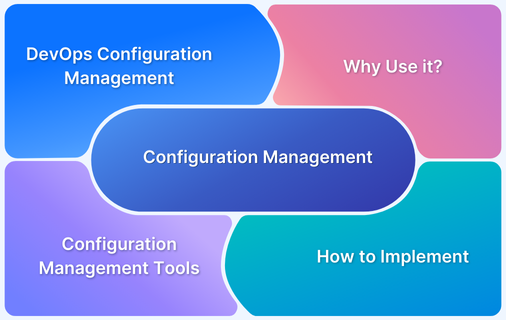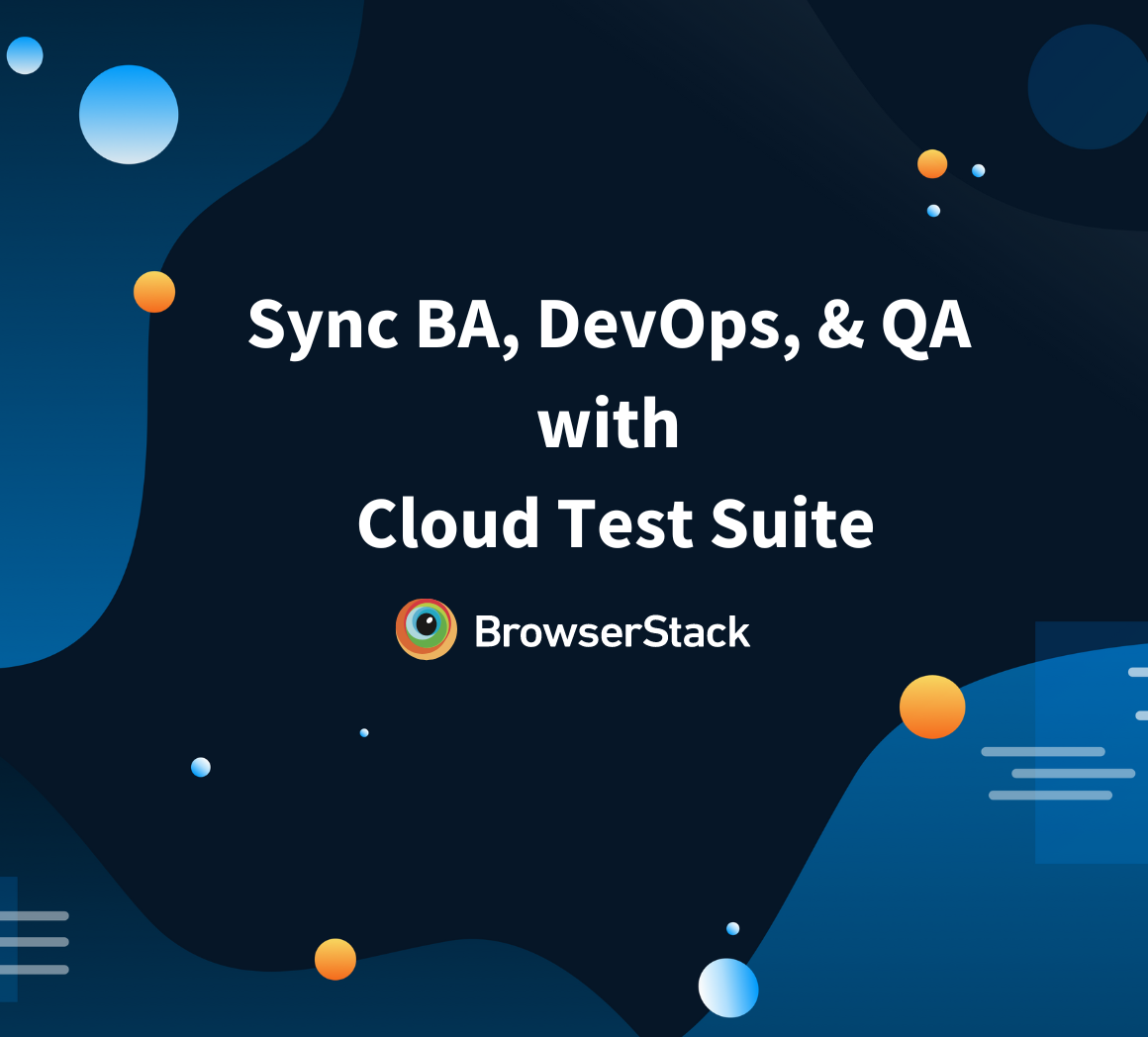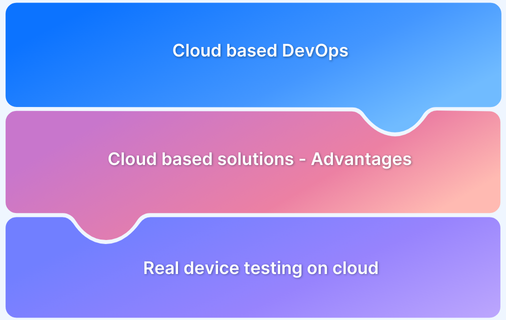DevOps has become an integral part of cloud projects, leading to the rise of Cloud DevOps; a powerful combination of DevOps and cloud computing.
Overview
What is Cloud DevOps?
Cloud DevOps integrates cloud computing and DevOps practices to enable faster development and scaling of applications. It uses cloud infrastructure and solutions to facilitate DevOps workflows, focusing on automation, CI/CD and collaboration between development and operation teams.
How do DevOps and Cloud work together?
- Cloud Infrastructure supports DevOps, enabling faster development and scalability.
- CloudSecOps combines IT security and operations to protect cloud assets
- DevOps as a Service platform enables organizations to set up (CI/CD) pipelines via the cloud without adopting multiple technologies.
This article explores cloud DevOps, how DevOps and the cloud work together, the tools used, best practices, and more.
What is Cloud DevOps?
DevOps can be considered as a set of practices, tools and philosophy that is used to automate and integrate the processes between Software Development and IT teams. This helps in improving the product quality and accelerate time to market.
Cloud, on the other hand, allows for simultaneous development to occur enabling continuous collaboration between different teams across the globe. When DevOps and Cloud Solutions work together in an environment that is built for flexibility and agility, it can be termed as Cloud DevOps.
As per a study conducted to test the software delivery performance, over 900 IT professionals around the world were surveyed on how they achieve success while software delivery and it was observed that the companies using both DevOps and Cloud had their performance increased by 81%.
Who is involved in Cloud DevOps?
Cloud DevOps is performed by a team of professionals called the Cloud DevOps engineers. They specialize in developing, operating, automating managing, and delivering cloud-based applications, supporting infrastructure, and the software delivery pipeline. These engineers work closely with developers, operations staff, and other IT professionals to bridge the gap between development and operations.
Also Read: The Role of QA in DevOps
How do DevOps and Cloud work together?
Some of the ways in which DevOps and Cloud work together are:
1. Cloud is leveraged by DevOps:
Organizations utilizing DevOps manage and automate their infrastructure using Cloud Computing technologies. This enables them to follow an agile approach to different work processes. DevOps processes are said to be very agile when implemented efficiently, but they can face limitations of an on-premise environment every now and then.
For instance, if an organization needs to start building a new software project or scale up an existing production application, it can cause needless delays and complexity for DevOps teams.
In cases like this, Cloud infrastructure offers an important boost for DevOps. It minimizes the latency and enables centralized management via a unified platform for deploying, testing, integrating, and releasing applications. They also offer CI/CD tools to automate DevOps processes. This enables the DevOps teams to collaborate among each other across distributed enterprise environments along with adapting to the changing requirements.
Cloud DevOps solutions are often said to be more cost-effective than on-prem automation solutions. They facilitate governance by unifying the different environments and reducing the security burden on teams. This high level cloud-based DevOps automation helps minimize human error and streamline repeatable processes and tasks.
Must Read: Why DevOps Teams Need Cloud-Based Solutions
2. CloudSecOps (Cloud Security Operations):
SecOps or Security Operations is a collaboration between IT security and IT operations. It integrates processes, tools and technology to keep an enterprise secure along with reducing any associated risks. Cloud security operations or CloudSecOps is an evolution of SecOps that aims to identify, respond, and recover systems from attacks targeting an organization’s cloud assets.
CloudSecOps teams have several roles. Some of them are:
- Incident management: Identifies security incidents, responds to them, and coordinates the response with legal and communication teams.
- Event Prioritization: Prioritizing events based on risk score calculation for cloud systems, accounts, and devices, and identifying cloud data sensitivity.
- Threat hunting: Discovering advanced security threats with the help of tools that filter out the noise from security monitoring solutions enabling advanced investigation of data.
3. DevOps as a Service:
DevOps as a Service is a set of cloud-based tools that enables collaboration between the development and operations teams of an organization. This toolset covers all the relevant DevOps processes and provides them as a unified platform where the teams select the tools they want for each purpose.
DevOps as a Service platform enables organizations to set up continuous integration / continuous delivery (CI/CD) pipelines via the cloud to increase development velocity and provide continuous feedback to the developers. This way the team can access any relevant technology without having to find, adopt, and learn multiple tools.
What are the Cloud DevOps tools?
The world’s leading cloud providers like AWS, Azure, and Google are excellent cloud DevOps tools. They provide a number of ‘DevOps as a Service’ offerings. Each of them provides an end-to-end environment for DevOps teams, eliminating the need for them to download, learn, and integrate multiple-point solutions.
Cloud DevOps tools
- AWS DevOps Tools
- Azure DevOps Tools
- Google DevOps Tools
1. AWS DevOps Tools
AWS DevOps tools offer functionalities to help teams automate, manage, and streamline software development and deployment in the AWS cloud. Below mentioned are the cloud and DevOps services provided by AWS:
- AWS CodePipeline: It builds, tests, and deploys code every time there is a code change based on the predefined release workflow models. This enables rapid and reliable delivery of features and updates.
Integrate your AWS CodePipeline with BrowserStack
- AWS CodeBuild: Compiles the source code, runs the tests, and generates ready-to-deploy software packages. It scales continuously and processes several builds concurrently enabling CI/CD in the cloud.
- AWS CodeDeploy: Automates code deployments to any instance, including on-premises servers, AWS EC2, AWS Lambda, etc. It facilitates rapid releases of new features, handles complexities associated with application updates, and can help avoid downtime during deployment.
- AWS CodeStar: Helps in quickly developing, building, and deploying applications on AWS. It’s a unified user interface that enables one to easily manage software development activities in one place.
- AWS CodeCommit: Helps to host secure and highly scalable private Git repositories and can be used to securely store anything from source code to binaries. It works seamlessly with the existing Git tools.
2. Azure DevOps Tools
Azure DevOps tools provide a comprehensive set of services like version control, build automation, continuous integration/continuous deployment, and more to streamline DevOps practices. Here are some of the Cloud DevOps services provided by Azure:
- Azure Pipelines: Builds and tests project codes automatically. It utilizes CI/CD while building, testing, and shipping the code to the respective environment of choice. The service also supports a number of programming languages and project types.
Integrate your Azure Pipeline with BrowserStack
- Azure Boards: Provides interactive and customizable tools for managing software projects. It offers a variety of capabilities including calendar views, native support for Scrum, Kanban, and Agile processes, reporting, and configurable dashboards.
- Azure Repos: Provides version control tools to help manage the project code. The service also offers GIT and Team Foundation Version Control (TFVC) to manage the different code versions.
- Azure Test Plans: Provides tools for driving quality and collaboration across the SDLC. This includes capabilities for various types of testing such as manual testing, automation testing, exploratory testing, etc, along with work items for feedback and reviews.
- Azure Artifacts: Manages the dependencies used in the source code. It can host and share packages publicly or privately with your team or the entire organization. It also supports a range of package types, such as npm, NuGet, Python, Universal Packages, and Maven.
Also Read: How to Build an Azure CI/CD Pipeline?
3. Google DevOps Tools
Google DevOps tools are a suite of DevOps tools and services offered by Google Cloud Platform to facilitate app development, deployment, and management. Given below are some of the best Cloud DevOps services provided by Google:
- Google Cloud Build: Executes the project builds on Google Cloud Platform infrastructure. It can import source code from Google Cloud Storage, Cloud Source Repositories, or GitHub, execute builds as per the required specifications, and produce artifacts such as Docker containers or Java archives.
Integrate your Google Cloud Build with BrowserStack
- Google Cloud Deploy: Automates applications’ delivery to a series of target environments in a defined promotion sequence. An updated application can be deployed by creating a release which is then managed by the delivery pipeline for the entire lifecycle of its release.
- Google Artifact Registry: Centrally manages artifacts and dependencies. It provides simple integration with existing CI/CD tools so that automated pipelines can be set up.
- Google Cloud Monitoring: Collects metrics, events, and metadata from various sources, including Google Cloud, AWS, etc. Google Cloud’s operations suite ingests this data and generates insights as charts, alerts, and dashboards.
Advantages of Cloud DevOps
Here are the most popular benefits of cloud DevOps
- Offers a Centralized Platform: The cloud provides a centralized platform for companies to manage testing, deployment, operating, and production work monitoring. When all information can be tracked from a unified space, managing compliance and security and procuring business insights become easier.
Also Read: Testing in Production: A Detailed Guide
- Options for Cloud-Centric Automation: Cloud platforms provide advanced tools for automating through DevOps processes, such as continuous integration and continuous development. Tools used for continuous integration, like CircleCI, GitLab, Jenkins andTravis CI, ensure speed and consistency without much human involvement.
- Better Scalability: Backed by the cloud, you can downsize or upscale any infrastructure according to your requirements. It doesn’t require you to spend much time and money on systems. This kind of scalability further helps you to leverage new opportunities and roll out new functionalities as your business expands. Moreover, you can combine the nimbleness of DevOps and the cloud to access many development opportunities.
- Fast and Agile Development: The DevOps team can wait for the required servers to become available before proceeding with their work since the cloud offers various testing and staging servers. Using DevOps with the cloud helps with better experimentation since builds occur at speed. Teams can quickly provision servers that are suitable to meet their needs.
- Cost-Effective: DevOps automates manual tasks and cloud providers improve stability and uptime as they handle all the maintenance and management aspects of the platform. Therefore, IT teams can focus on product development to improve user experience and product performance and accelerate the time to market. All this leads to a cost-effective process.
Why Integrate your DevOps Tool with BrowserStack?
Testing the software application is an integral part of Cloud DevOps and integrating a testing platform like Browserstack with your DevOps tool comes with several benefits.
- Integrations with a Myriad of DevOps Tools: BrowserStack integrates seamlessly with a long list of popular CI/CD tools like Jenkins, CircleCI, TravisCI, TeamCity GitLab, etc, to run automated tests in parallel while facilitating the development process.
- Automated Cross-Browser Testing: BrowserStack lets you automate your cross-browser tests as part of your CI/CD pipeline and speed up the development of your app. It provides a cloud Selenium grid of 3500+ real browsers and devices for the purpose.
- Better Test Coverage: BrowserStack provides access to a vast cloud of real devices and browsers, enabling users to test in different environments and scale their testing efforts without the need for physical devices.
- Quicker Feedback Loops: By integrating your DevOps tools with BrowserStack, your team can receive quick feedback on their code’s compatibility. This will further help in faster resolution of issues and release cycles.
- Comprehensive Testing: By providing access to 3500+ real device, browser, and OS combinations, BrowserStack offers a comprehensive testing experience taking real user conditions into consideration.
- Leverage Robust Features: Integrate your Cloud DevOps tools with BrowserStack to leverage features like Parallel Testing, comprehensive reports, and integration with Reporting tools such as Slack, GitHub, Trello, and Jira.
Best Practices in Cloud DevOps
Here are the best practices you can follow to optimize cloud DevOps efforts.
- Continuous Integration/Continuous Delivery: CI/CD pipeline is the heart of the DevOps philosophy where CI (continuous integration) means building and regularly validating the project by updating code changes at regular intervals and CD (continuous delivery) means automatically deploying code in the production environment.
- Performance Testing: Leverage automated performance testing to test your application’s performance at regular intervals. This will increase the chances of issues getting noticed earlier and improve performance as well.
- Constant Tracking and Logging: Monitor and record all system activities to help trigger events at the right time. While continuous monitoring helps in correcting areas that do not perform well, continuous logging detects issues for quick resolution.
- Integrate Containers: Compartmentalize apps through containers to work on specific areas without interrupting others. Thus, simplifying the process of deploying and updating apps.
- Invest in Infrastructure: Investing in a good infrastructure is essential for streamlining DevOps processes and making them cost-effective.
- Effective Communication: Communicate and collaborate with your team continuously. The entire team should be updated with relevant information and feedback exchange should be encouraged.
Conclusion
The development of enterprises in today’s era relies predominantly on bringing software into operations. This digital transformation requires enterprises to take a leap of faith towards DevOps and Cloud. There are many DevOps tools like AWS, Azure, and Google Cloud Platform to support this transformation. Integrate them with tools like BrowserStack to test your apps on 3500+ real devices, browser, and OS combinations to understand how they work under real user conditions.
Frequently Asked Questions
1. Are DevOps and Cloud Ops the same?
DevOps and Cloud Ops are similar but not the same. While DevOps focuses on automating and streamlining SDLC, CloudOps applies DevOps principles to specifically manage and optimize cloud-based infrastructure and services.
2. Does DevOps need coding?
Yes, but coding is just one aspect of DevOps. It also focuses on improving collaboration and automation in software development and IT operations.
3. What is the difference between cloud and DevOps
Cloud is about managing and optimizing internet-based infrastructure, while DevOps focuses on improving how teams develop and deliver software.
Useful Resources for DevOps
Understanding DevOps:
- What is DevOps
- DevOps Shift Left Testing: A Detailed Guide
- What is the ultimate goal of DevOps?
- Benefits of DevOps
- What is DevOps Configuration Management?
- What is Continuous Delivery in DevOps?
- What is a DevOps Pipeline? How to Build One
- What is DevOps Observability (Importance & Best Practices)
- DevOps Testing Strategy
- How to improve DevOps Feedback Loop
- Python For DevOps: An Ultimate Guide
- What is DevOps Automation and How is it Helpful?
- Importance of DevOps Team Structure
- The Role of QA in DevOps
- Top Challenges in DevOps and How to Solve Them
- Top 21 Monitoring Tools in DevOps for 2024
Know the difference:
- DevOps vs Scrum: Key Differences
- Breaking Down MLOps vs DevOps: Similarities and Differences
- DevOps vs SysOps: What are the major differences
- DataOps vs DevOps: Key Differences
- TechOps, DevOps, and NoOps: Which one is right for you?
- DevOps vs CloudOps: How are they different
- DevOps Engineer vs Full Stack Developer: Differences
- Synchronize Business Analysis, DevOps, and QA with Cloud Testing





